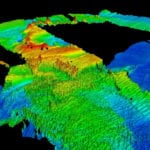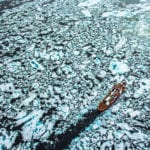Q&A with Paul Sokoloff
From the Canadian Arctic to the deserts of Southern Utah, Paul Sokoloff captures the beauty of nature from the plants in the ground to the stars in the sky. Paul is a botanist at the Canadian Museum of Nature and a member of the Arctic Flora of Canada and Alaska project. He works to catalogue plant and lichen biodiversity in the Arctic, among other places, and conducts biological expeditions at the Mars Desert Research Station.
Paul is a multi-year Visualizing Science Contest participant, winning the Grand Prize in 2016 and later having one of his images selected for the 2018 cover of Botany.
You’ve completed expeditions at the Mars Desert Research Station. What have you learned about taking photos in space?
While I haven’t been able to take photos from space itself, I would be on a rocket with my camera in a heartbeat if I were offered the chance (Canadian Space Agency, are you reading this?). I have had the privilege of shooting photos in some of the most interesting places on our own planet, like across the Canadian Arctic and in the Mars-like deserts of southeast Utah. Some of the lessons I’ve learned along the way are applicable to photography in many extreme environments, like space. Packing a light but flexible kit is one key, even if you’re packing airline carry-on instead of crew capsule stowage. A few multi-use lenses can carry all but the most ardent gearheads far. In that same vein, make sure you don’t forget mission-critical items at home, because the ship isn’t turning back. Secondly, dust will be your enemy in every space you shoot in (especially the desert), so come prepared with an air blaster and a tough, dustproof case for your equipment. Lastly, don’t hesitate to share tips with your crewmates, who will be there for you when you might need a windbreak for plant photography.

Betula glandulosa | Paul Sokoloff
Tell us about a time when taking a photo didn’t go as planned
What’s the old saying, something like “the best camera you have is the one that is on you?”. What if you forgot to bring the camera along in the first place? A few years back I was conducting botanical research on Somerset Island, in Nunavut, Canada, sponsored by the Canadian Museum of Nature and Weber Arctic. Towards the end of the trip, I had the opportunity to join guides and guests from Arctic Watch Lodge on a rafting trip along the Cunningham River, where I could sample plants along the way. Not wanting to risk getting my new camera wet (and not fully trusting my dry bag), I decided only to pack my small GoPro. Later that day, as our raft turned a corner, we found ourselves face to face with a small herd of Muskox. As the lodge guests whipped out their cameras and telephoto lenses, all I could do was pull out the small GoPro to find out the battery was exhausted. Photo fail indeed.

Stars over San Rafael “Planitia” | Paul Sokoloff
What techniques do you use for imaging night skies?
For night sky photography, especially Milky Way and constellation shots (some of my favorites), I will combine a slow shutter speed and wide-open aperture for a long exposure shot that captures faint detail in massive dark. I use a mirrorless system and will change lenses depending on the image I’m trying to achieve. In late summer/early fall, when the galactic disk stretches high over the Northern Hemisphere, I will use a wide-angle lens (12 mm, f 2.0) to take it all in. When I want to photograph a specific constellation or cluster, I will use a fast prime lens (30 mm, f 1.4), coupled with a fog filter to enhance the brightest stars. In every session, a few basic essentials are a sturdy tripod, knowing the timing of the new moon and cloudy skies, and a dark sky away from light pollution (though a didymium glass filter can help cut out the wavelengths emitted from sodium lamps). Don’t forget to play around with your ISO to find the right level between sensitivity and noise.




